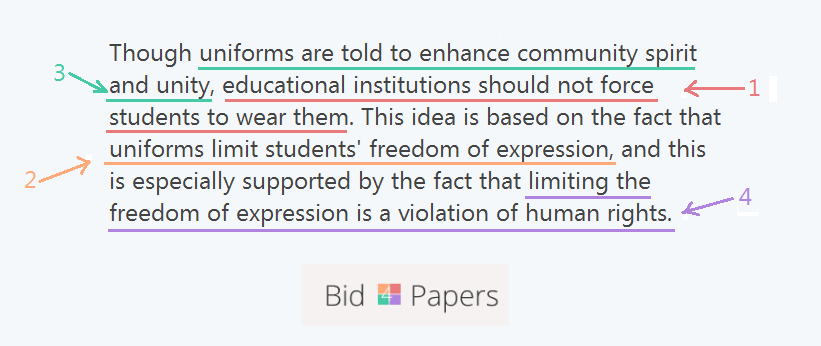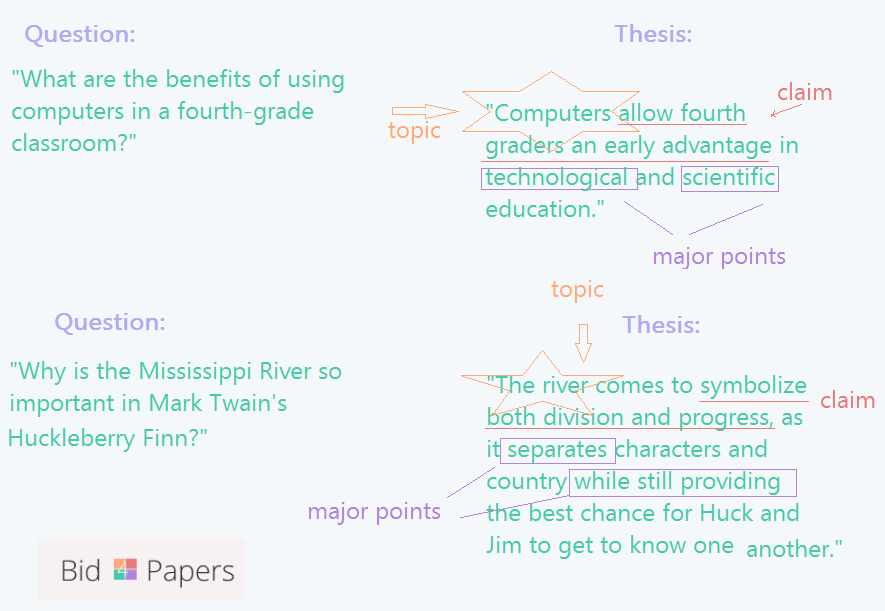strong thesis statement что это
How to Write a Strong Thesis Statement
Bad news about thesis statement goes first:
You won’t get an A for an essay if it doesn’t have a thesis statement. It is one of the first things your teacher looks for and one of the main factors for your grade.
And this is where most students run into trouble:
Take it easy! Good news is on its way:
This article is here to explain everything in plain English and share actionable tips with you on how to write strong thesis statements for your academic papers.
So, what is a thesis statement?
Definition of thesis is simple:
It’s a sentence or two at the end of the introduction to your paper that explains a central claim you’ll discuss and prove in each of the following paragraphs.
Attention, please!
Do not confuse thesis statements with introductions, as most students asking how to start an essay do! An essay thesis closes your introduction rather than substitutes it. Hook readers first, then introduce your topic, and only then state a thesis.
In other words, it’s the heart of your essay. It explains to the reader what your paper will be about.
Why write a thesis statement
First, a strong thesis statement influences your teacher’s feedback on your essay and your final grade for it.
Second, it makes a paper logical and focused, simplifying the writing process for you: once you figure out the main idea for yourself and express it in a clear, brief, and intelligible thesis statement, all the following paragraphs of your paper will be based on it.
As a result, you won’t be distracted by your reasoning and therefore avoid the risk of turning your essay into gibberish full of weak arguments.
And third, it summarizes your topic and declares your position on it. You need a strong thesis statement for the audience to understand if your paper is something they want to read.
The elements of a thesis statement
An essay thesis consists of four elements:
When you have all the four points, you should organize them in a coherent sentence or two using transitions and linking words.
Here is an example of a thesis statement with all the necessary elements:
How to know your statement is strong
In other words, your thesis should identify the topic, the claim, and the major points you’ll use in an essay to support the claim.
Thesis statement examples (1):
“Stress in the fast-food workplace has led to serious physical, psychological, and emotional problems for employees.”
Topic: stress in the fast-food workplace
Claim: led to serious problems
Major points: physical problems, psychological problems, emotional problems
Thesis statement examples (2):
“Advertisers target young people when marketing cigarettes, alcohol, and adult movies.”
Topic: aggressive advertising
Claim: wrong targetting young people
Major points: cigarettes, alcohol, and adult movies
Attention, please!
A thesis is an interpretation of a subject, not the subject itself. Also, choose a claim that others might dispute. It should be specific and express one main idea.
Do ALL essay types need a thesis statement?
Hope is the last to die, right?
Sorry to disappoint you but yes, a thesis statement is a fundamental element of nearly any type of paper, apart from, possibly, creative writing.
When you write it wrong, and how to change that
The most common mistake that undermines the strength of a thesis statement in the essay is making a descriptive thesis instead of an argumentative one.
Descriptive is a statement that simply names the topic but doesn’t present any claim and major points.
Example:
Let’s say you write an essay about the relevance of uniforms at schools.
Your descriptive thesis statement would be:
“This paper will discuss whether students have to wear school uniforms because this issue has two sides and the arguments on both are compelling.”
Your argumentative thesis statement may be as follows:
“Though uniforms are told to enhance community spirit and unity, educational institutions should not force students to wear them. This idea is based on the fact that uniforms limit students’ freedom of expression, and this is especially supported by the fact that limiting the freedom of expression is a violation of human rights.”
Why the descriptive one doesn’t work? Because it simply duplicates the title of your paper and does not enlighten on the work you are supposed to do as a student.
So here go some tips for you to write strong thesis statements:
Now, everything you need to do is tailor your statement to the type of paper you are assigned to write and limit it to one or two sentences in length.
Example:
To ease the process, you can try online thesis statement generator: write your topic, claim, and major points there – and get your thesis statement, strong and ready to rock the world.
It’s not only a marker of good academic writing but also an aid for the logic of your writing. A strong thesis statement should exactly communicate what you want to tell in your paper and be as concise as possible.
Our Writing Guides
How to Improve the US Education System
Infographic: opposite habits of famous authors
Infographic: You Are What You Read
Get Updates
11 thoughts on “ How to Write a Strong Thesis Statement ”
Thanks for this article! It helped me write essay intro yesterday!
How to Write a Strong Thesis Statement
Published September 2, 2020. Updated November 12, 2020.
A thesis can be found in many places—a debate speech, a lawyer’s closing argument, even an advertisement. But the most common place for a thesis statement (and probably why you’re reading this article) is in an essay.
Whether you’re writing an argumentative paper, an informative essay, or a compare/contrast statement, you need a thesis. Without a thesis, your argument falls flat and your information is unfocused. Since a thesis is so important, it’s probably a good idea to look at some tips on how to put together a strong one.
 What is a “thesis statement” anyway?
What is a “thesis statement” anyway?
You may have heard of something called a “thesis.” It’s what seniors commonly refer to as their final paper before graduation. That’s not what we’re talking about here. That type of thesis is a long, well-written paper that takes years to piece together.
Instead, we’re talking about a single sentence that ties together the main idea of any argument. In the context of student essays, it’s a statement that summarizes your topic and declares your position on it. This sentence can tell a reader whether your essay is something they want to read.
 2 Categories of Thesis Statements: Informative and Persuasive
2 Categories of Thesis Statements: Informative and Persuasive
Just as there are different types of essays, there are different types of thesis statements. The thesis should match the essay.
For example, with an informative essay, you should compose an informative thesis (rather than argumentative). You want to declare your intentions in this essay and guide the reader to the conclusion that you reach.
Example:
To make a peanut butter and jelly sandwich, you must procure the ingredients, find a knife, and spread the condiments.
This thesis showed the reader the topic (a type of sandwich) and the direction the essay will take (describing how the sandwich is made).
Most other types of essays, whether compare/contrast, argumentative, or narrative, have thesis statements that take a position and argue it. In other words, unless your purpose is simply to inform, your thesis is considered persuasive. A persuasive thesis usually contains an opinion and the reason why your opinion is true.
Example:
Peanut butter and jelly sandwiches are the best type of sandwich because they are versatile, easy to make, and taste good.
In this persuasive thesis statement, you see that I state my opinion (the best type of sandwich), which means I have chosen a stance. Next, I explain that my opinion is correct with several key reasons. This persuasive type of thesis can be used in any essay that contains the writer’s opinion, including, as I mentioned above, compare/contrast essays, narrative essays, and so on.
 2 Styles of Thesis Statements
2 Styles of Thesis Statements
Just as there are two different types of thesis statements (informative and persuasive), there are two basic styles you can use.
The first style uses a list of two or more points. This style of thesis is perfect for a brief essay that contains only two or three body paragraphs. This basic five-paragraph essay is typical of middle and high school assignments.
Example:
C.S. Lewis’s Chronicles of Narnia series is one of the richest works of the 20th century because it offers an escape from reality, teaches readers to have faith even when they don’t understand, and contains a host of vibrant characters.
In the above persuasive thesis, you can see my opinion about Narnia followed by three clear reasons. This thesis is perfect for setting up a tidy five-paragraph essay.
In college, five paragraph essays become few and far between as essay length gets longer. Can you imagine having only five paragraphs in a six-page paper? For a longer essay, you need a thesis statement that is more versatile. Instead of listing two or three distinct points, a thesis can list one overarching point that all body paragraphs tie into.
Example:
Good vs. evil is the main theme of Lewis’s Narnia series, as is made clear through the struggles the main characters face in each book.
In this thesis, I have made a claim about the theme in Narnia followed by my reasoning. The broader scope of this thesis allows me to write about each of the series’ seven novels. I am no longer limited in how many body paragraphs I can logically use.
 Formula for a Strong Argumentative Thesis
Formula for a Strong Argumentative Thesis
One thing I find that is helpful for students is having a clear template. While students rarely end up with a thesis that follows this exact wording, the following template creates a good starting point:
___________ is true because of ___________, ___________, and ___________.
Conversely, the formula for a thesis with only one point might follow this template:
___________________ is true because of _____________________.
Students usually end up using different terminology than simply “because,” but having a template is always helpful to get the creative juices flowing.
 The Qualities of a Solid Thesis Statement
The Qualities of a Solid Thesis Statement
When composing a thesis, you must consider not only the format, but other qualities like length, position in the essay, and how strong the argument is.
Length: A thesis statement can be short or long, depending on how many points it mentions. Typically, however, it is only one concise sentence. It does contain at least two clauses, usually an independent clause (the opinion) and a dependent clause (the reasons). You probably should aim for a single sentence that is at least two lines, or about 30 to 40 words long.
Position: A thesis statement always belongs at the beginning of an essay. This is because it is a sentence that tells the reader what the writer is going to discuss. Teachers will have different preferences for the precise location of the thesis, but a good rule of thumb is in the introduction paragraph, within the last two or three sentences.
Strength: Finally, for a persuasive thesis to be strong, it needs to be arguable. This means that the statement is not obvious, and it is not something that everyone agrees is true.
Example of weak thesis:
Peanut butter and jelly sandwiches are easy to make because it just takes three ingredients.
Most people would agree that PB&J is one of the easiest sandwiches in the American lunch repertoire.
Example of a stronger thesis:
Peanut butter and jelly sandwiches are fun to eat because they always slide around.
This is more arguable because there are plenty of folks who might think a PB&J is messy or slimy rather than fun.
Composing a thesis statement does take a bit more thought than many other parts of an essay. However, because a thesis statement can contain an entire argument in just a few words, it is worth taking the extra time to compose this sentence. It can direct your research and your argument so that your essay is tight, focused, and makes readers think.
The Ultimate Guide to Writing a Thesis Statement
A thesis statement is a sentence in a paper or essay (in the opening paragraph) that introduces the main topic to the reader. As one of the first things your reader sees, your thesis statement is one of the most important sentences in your entire paper—but also one of the hardest to write!
In this article, we explain how to write a thesis statement in the best way possible. We look at what to include and the steps to take for writing your own, along with plenty of thesis statement examples to guide you.
What is a thesis statement?
The goal of a thesis statement is to let your reader know what your paper or essay is about. It helps your reader understand the greater context and scope of your topic, plus it lets your readers know what to expect from the rest of the work.
A secondary benefit of a thesis statement is that it makes it easier to search for papers on a particular topic, especially in the realm of academic writing like research papers and thesis papers (which are sometimes known as dissertations when written for doctoral degrees). For example, if you’re writing a paper of your own, you’ll want to look up other papers to use as evidence and sources. You can simply scan the thesis statements of several papers to see which match your topic and could be worthwhile sources to cite.
What to include in a thesis statement (with examples)
How to write a thesis statement for expository and argumentative essays
Expository and argumentative essays are some of the most common types of academic papers. Because they don’t have a formal abstract like research papers, they rely on their thesis statements to provide an overview of what’s discussed.
Thesis statements for argumentative and expository essays should use strong and decisive language; don’t be wishy-washy or uncertain. You want to take a stand right in the opening so that your readers understand what your paper is trying to show.
Moreover, thesis statements for these essays should be specific, with some minor details to hint at the rest of the paper. It’s not enough to merely make your point; you also want to provide some basic evidence or background context to paint a full picture.
If your paper dives into different subtopics or categories, try to fit them into the thesis statement if you can. You don’t have to get into details here, but it’s nice to mention the different sections at the top so that the reader knows what to expect.
Thesis statement examples
Despite the taboo, insects make an excellent food source and could stem humanity’s looming food shortage, based on both their protein output and the sustainability of farming them.
The backlash to rock ’n’ roll music in the ’50s by religious groups and traditionalists actually boosted the genre’s popularity instead of diminishing it as intended.
How to write a thesis statement for persuasive essays
Similar to argumentative essays, persuasive essays follow many of the same guidelines for their thesis statements: decisive language, specific details, and mentions of subtopics.
Furthermore, unlike with other essays, it’s appropriate to make emotional connections in a thesis statement in persuasive essays. This can actually be a clever strategy to start your essay off on a more personal, impactful note.
Thesis statement examples
Advertising should not be allowed in public schools because it’s a distraction from studies and may lead to misguided priorities among the school board, to say nothing of the materialist culture it promotes.
Exotic pets provide the same love and companionship as conventional pets, so the laws regulating which animals can and cannot be kept as pets should be more relaxed.
How to write a thesis statement for compare-and-contrast essays
Thesis statements for compare-and-contrast essays are tricky because you have at least two topics to touch on instead of just one. The same general guidelines apply (decisive language, details, etc.), but you need to give equal attention to both your topics—otherwise, your essay will seem biased from the start.
As always, your thesis statement should reflect what’s written in the rest of your essay. If your essay spends more time comparing than contrasting, your thesis statement should focus more on similarities than differences.
It sometimes helps to give specific examples as well, but keep them simple and brief. Save the finer details for the body of your essay.
Thesis statement examples
Sean Connery and Daniel Craig are the two most popular actors to portray James Bond, but both have their own distinct and at times contradictory interpretations of the character.
While capitalism and communism are often viewed as diametric opposites, the truth is that, in practice, both ideologies tend to “borrow” principles from one another.
How to write a thesis statement in 3 steps
Now that you know what you’re aiming for, it’s time to sit down and write your own thesis statement. To keep you on track, here are three easy steps to guide you.
1 Brainstorm the best topic for your essay
You can’t write a thesis statement until you know what your paper is about, so your first step is choosing a topic.
Once you’ve chosen a topic—and the angle or stance you want to take—then it’s time to put the idea for your thesis sentence into words.
2 Phrase your topic as a question and then answer it
It’s not always easy to fit your entire thesis into just one sentence, let alone one that’s written clearly and eloquently. Here’s a quick technique to help you get started.
First, phrase your topic as a question. For example, if you want to write about Mahatma Gandhi’s legacy, ask yourself, “What influences did Gandhi have on society after his death?”
3 Add some polish
Chances are, your first attempt at a thesis statement won’t be perfect. To get it to its best, try revising, editing, and adding what’s missing.
Remember the core traits for thesis statements we mentioned above: decisive language, a happy medium of specific but not too specific details, and mention of subtopics. If you’re struggling to contain everything in a single sentence, feel free to move the secondary information to the following sentence. The thesis statement itself should only have what’s most necessary.
If you’re in doubt, read your thesis statement to a friend and ask them what they think your paper is about. If they answer correctly, your thesis statement does its job.
Next comes the hard part—writing the rest! While the bulk of the writing lies ahead, at least you’ve nailed down your central idea. To plot out your supporting argument, follow our advice on essay structure and let your ideas flow.
How to Write a Strong Thesis Statement: Great Tips + Examples!
Writing a thesis statement may seem to be an impossible task at first. There’s a good reason for that! It may not be simple to convey the idea of the whole essay in one or a couple of sentences. But no worries! With the right guidance, it can be done easily. With practice, it will become as easy as pie. But a beginner will find a lot of valuable information in this article.
What Is a Thesis Statement?
So, how should you understand the notion of a thesis statement? Just remember, a thesis is the key to understanding the whole essay. It is one or a couple of sentences placed at the end of the introductory part of an essay. It is a core idea of the writing, or the central argument, which tells the reader what the paper is about and demonstrates the author’s viewpoint.
Why Is a Thesis Statement Important in an Essay?
Even if you do not know how to generate a strong thesis statement, you cannot omit this essential paper element. It should be very specific and well-thought-out. Try perceiving it as a guide both for you and your readers because a thesis statement:
What Is a Strong Thesis Statement?
Generating a strong thesis statement means that it meets the essential requirements. Students often ask «How do I Know that My Thesis Statement Is Strong?». Luckily, there is a checklist you can follow while working on this element of a paper. You can use these tips and thesis statement examples while working on your next paper.
What Should I Include and Avoid in a Thesis Statement?
Before you start writing a thesis statement for your paper, make sure that you understand what its format should be. Also, it is crucial to know the key components that make a strong thesis statement.
What to include?
What to Avoid?
Students who are confident in researching information and creating a compelling piece of writing still sometimes struggle with generating a good thesis statement. It is quite easy to miss essential factors while being stressed about workload and deadlines. Take your time to check this simple list of pitfalls to avoid when working on the thesis.
How to Write a Strong Thesis Statement Step by Step
Anybody can generate a thesis statement. But creating a strong thesis is more complicated and requires preparation. So, here’re some ideas on how to start writing a thesis statement:
Great Examples of Thesis Statements for Different Types of Essay
There are various types of essays, each having its own purpose. Logically, thesis statements also differ based on type of paper. However, having read hundreds of papers, you start to notice some patterns. We have gathered the patterns of most popular essay types and thesis statement examples, so you could see the difference with your own eyes.
1.Research paper thesis statement
Every part of a research paper should be precise and to the point. A thesis statement is no exception. The reader doesn’t have to guess what you meant. Your point should be crystal clear. Preferably the thesis should demonstrate a causal relationship within your topic.
Example: “According to recent studies, having a counselor on the college campus decreases the frequency of substance abuse cases among students.”
2.Analytical thesis statement
An analytical essay gets to the root of the problem, answering the questions of why and how. A strong analytical thesis presents a claim that needs to be proven in the body paragraphs.
Example:“During World War I, its participants had various causes; burgeoning excessive patriotism fomented the feeling of anger and hatred towards the nationalities different from the Aryan race. It resulted in the war itself and proliferation.”
3.Persuasive thesis statement
First of all, a thesis statement for a persuasive essay should be debatable. It should convey a strong and confident claim that will later be proven in the body.
Example: “Evidence proves the fact kids imitate and internalize TV programming. Violent shows and movies have a negative impact on the mental health of an average child, they should forbid including any sort of violence in the television for the youngest audience.”
4.Compare and contrast thesis statement
The purpose of a compare and contrast essay is to find similarities and differences between two or more concepts. Consequently, a thesis statement for such an essay should demonstrate the results of the comparisons made.
Example: “Even though Egyptian & South American pyramids were different in many aspects, starting from their construction techniques and ending up with the way people perceive them, they had enough similar qualities. A high probability is they were built by geographically different individuals. They did not have a chance to contact each other. At the same time, their cultures had a lot in common, and it explains why the constructions have shared many common features.”
5.Expository thesis statement
The key peculiarity of an expository essay thesis is that it is not your opinion or claim. Such a thesis is written concisely and contains facts only.
Example: “The Fourth Industrial Revolution presents an opportunity to create a human-oriented future with the help of technology.”
6.Cause and effect thesis statement
In a thesis statement for a cause and effect paper, you should clearly indicate the focus of the essay. Will it be the cause, the effect, or maybe both? You do not necessarily need to indicate the words: cause or effect if they are implied in the context.
Example: “I will prove it is important to limit access to technology. Although technology can be used for the sake of humanity, it may jeopardize the confidentiality of people who apply it, lead to the problems with mental & physical health, and provoke social issues having a certain impact on public opinion.”
Where Should I Place Thesis Statement?
A thesis statement expresses the main idea and serves as a road map to the whole essay. Thus, it is usually placed at the end of the introductory part. It should not be added in the main body or conclusion.
Can Thesis Statement Be a Question?
From the very term it becomes clear that it should be a statement. Thesis statement cannot be a question as it itself answers the main question of the paper.
Important note: Topic sentences of the body paragraphs could be questions. In the body paragraphs, a writer has to provide answers and explanations, and that is why they may start with a question.
Can Thesis Statement Be a Quote?
Thesis statement should be paper-specific and express your opinion regarding the topic discussed in paper. A quote presupposed citing other people’s opinions. Thus, it is logical that other people cannot know your opinion on a specific topic. Also, it is unlikely that someone has already written about your viewpoint on this specific topic. Thus, a thesis statement cannot be a quote.
How Long Should a Thesis Statement Be?
Writers wonder how long should a thesis statement be and if the length of the entire paper affects its length. The answer is: no. No matter how long the paper you write is, whether it is APA or MLA paper, the thesis should not be longer than 3 sentences (1 sentence is the best option). The same way, an abstract has to be no longer than 250-300 words, which equals to 1/3 of the A4 page. It is a rule you should follow if you want to get a positive grade for your writing.
An original and thoughtful thesis statement serves as evidence that your essay is worth reading. It sounds like a lot of pressure, doesn’t it? Fortunately, there are useful guides that can help you master the skill of generating a strong thesis statement. However, sometimes it’s reasonable to search for professional help and advice anyway. Especially when you aку short of time due to other assignments or a job. If it’s the case, you can ask experts for writing assistance.







 What is a “thesis statement” anyway?
What is a “thesis statement” anyway? 2 Categories of Thesis Statements: Informative and Persuasive
2 Categories of Thesis Statements: Informative and Persuasive 2 Styles of Thesis Statements
2 Styles of Thesis Statements Formula for a Strong Argumentative Thesis
Formula for a Strong Argumentative Thesis The Qualities of a Solid Thesis Statement
The Qualities of a Solid Thesis Statement

